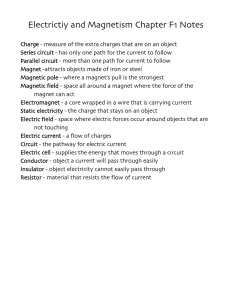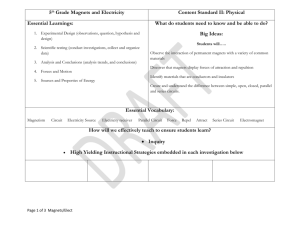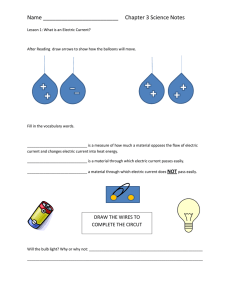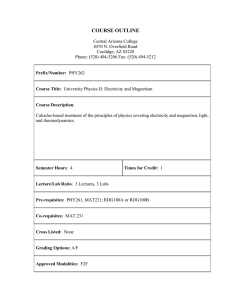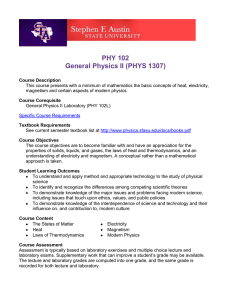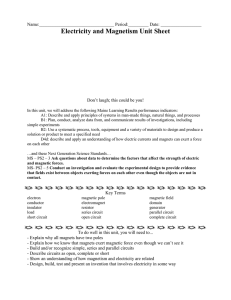MAGNETISM AND ELECTRICITY + –
advertisement
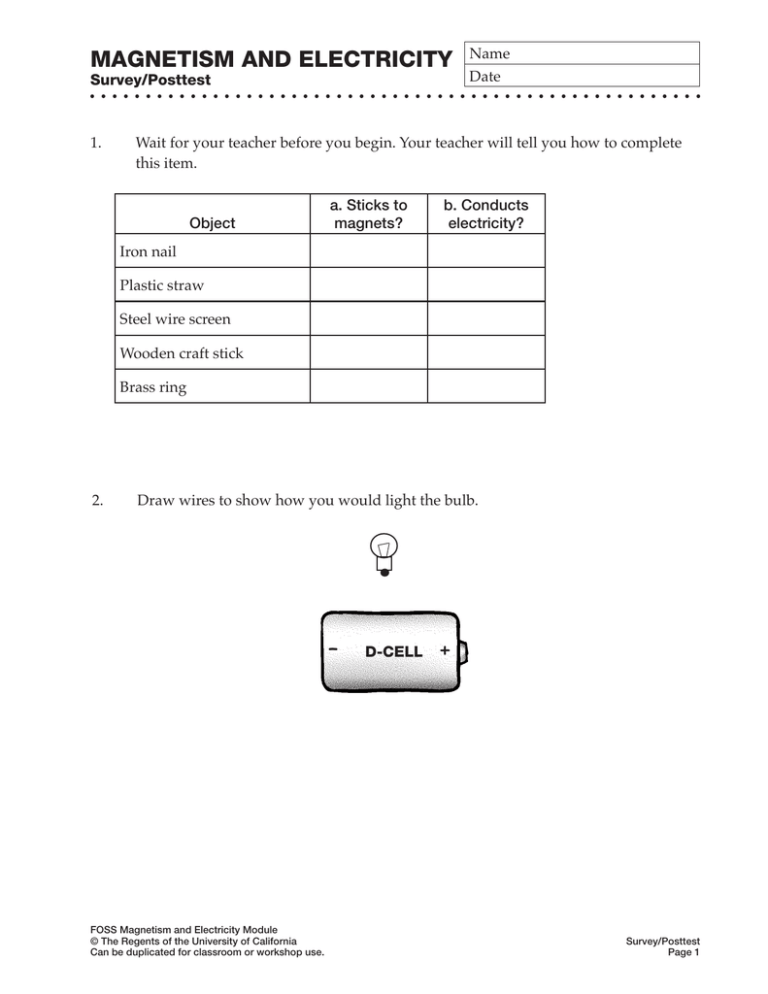
MAGNETISM AND ELECTRICITY Survey/Posttest 1. Name Date Wait for your teacher before you begin. Your teacher will tell you how to complete this item. Object a. Sticks to magnets? b. Conducts electricity? Iron nail Plastic straw Steel wire screen Wooden craft stick Brass ring 2. Draw wires to show how you would light the bulb. – FOSS Magnetism and Electricity Module © The Regents of the University of California Can be duplicated for classroom or workshop use. D-cell + Survey/Posttest Page 1 MAGNETISM AND ELECTRICITY Name Survey/Posttest Magnet 1 Magnet 2 S N Magnet 3 N S S N 3. Three bar magnets are held together as you see above. What are the magnets going to look like when they are released? A. N S S N S B. N S C. N S D. N S 4. Wendy is making an electromagnet. She wrapped a long, insulated wire around an iron nail. What should Wendy do next to complete the electromagnet? S N N S N S S N N S N S N FOSS Magnetism and Electricity Module © The Regents of the University of California Can be duplicated for classroom or workshop use. Survey/Posttest Page 2 MAGNETISM AND ELECTRICITY Name Survey/Posttest 5. Arthur was playing with magnets. He had one magnet on the table, and one in his hand. As he moved the magnet in his hand closer to the one on the table, the magnets suddenly snapped together. Explain to Arthur why the magnets snapped together. 6. Draw arrows on the picture to show which direction electricity flows through the circuit to run the motor. – FOSS Magnetism and Electricity Module © The Regents of the University of California Can be duplicated for classroom or workshop use. + D-cell Survey/Posttest Page 3 MAGNETISM AND ELECTRICITY Name Survey/Posttest 7. Look at the schematic diagram. • What will happen to the other two bulbs if the middle bulb burns out? • Why does that happen? 8. Annie was making an electromagnet. She had three rivets that she could use to wrap wire around. One was copper, one was iron, and one was steel. Which rivet or rivets should she use and why? FOSS Magnetism and Electricity Module © The Regents of the University of California Can be duplicated for classroom or workshop use. Survey/Posttest Page 4 MAGNETISM AND ELECTRICITY Name Survey/Posttest 9. Imagine you have a box of the following materials: a large iron nail, several permanent magnets, lots of insulated wire, a D-cell, and a switch. a. Describe one way to make the nail a temporary magnet. b. Describe another way to make the nail a temporary magnet. 10. Samuel Morse, the inventor of the telegraph, had a problem. His telegraph’s signal was too weak. He needed a stronger electromagnet. What is one way that he might have increased the strength of the electromagnet for his telegraph? FOSS Magnetism and Electricity Module © The Regents of the University of California Can be duplicated for classroom or workshop use. Survey/Posttest Page 5 MAGNETISM AND ELECTRICITY Name Survey/Posttest 11. Electricity can be changed into other forms of energy. • The bulb in a lamp changes electric energy into • A motor changes electric energy into 12. Julie placed a paper clip, piece of cardboard, and magnet together like you see in the pictures. Why did the paper clip stay against the cardboard rather than fall to the floor? . . FOSS Magnetism and Electricity Module © The Regents of the University of California Can be duplicated for classroom or workshop use. Survey/Posttest Page 6 MAGNETISM AND ELECTRICITY Name Survey/Posttest 13. A student set up the circuit you see in the picture. There was a compass sitting on the table next to the circuit. When the student connected the plastic-coated copper wire to the battery, the compass needle moved. Why did the compass needle move? A. Electricity was flowing through the wire to the compass. B. Magnetic force was flowing from the battery to the compass. C. The energy flowing through the wire caused the compass to vibrate. D. Magnetism was created when electricity flowed through the wire. 14. A student placed two horseshoe magnets near each other on a table. What will happen when she lets go of the two magnets? S N S (Circle the one best answer.) N (Circle the one best answer.) A. One side of the magnet will repel and the other side will attract. B. The two magnets will repel and push apart. C. The two magnets will attract and stick together. D. The force will be cancelled between the magnets. 15. When black sand and iron filings are mixed together, they look like a black powder. Which of the following would be the easiest way to separate the sand and the filings? (Circle the one best answer.) A. Use a magnifying glass. B. Add water to the mixture. C. Use a magnet. D. Use a hot plate to heat the mixture. FOSS Magnetism and Electricity Module © The Regents of the University of California Can be duplicated for classroom or workshop use. Survey/Posttest Page 7 Name Date I-CHECK Investigation 1—The Force 16. José discovered that he could move a magnet across the top of a wood table by moving another magnet under the table. Explain why José is able to move the magnet on top of the table without touching it. (2) (1) N ? pole S ? pole 17. Kari has a horseshoe magnet, but she isn’t sure which pole is the north pole. She also has a bar magnet marked N and S. How can Kari use her bar magnet to find out which pole of the horseshoe magnet is north? FOSS Magnetism and Electricity Module © The Regents of the University of California Can be duplicated for classroom or workshop use. Investigation 1 I-Check Page 1 I-CHECK Name Investigation 1—The Force 18. Anne is investigating objects and magnets. She recorded this in her science notebook. I was surprised! A nail was stuck to the magnet. When I accidentally touched the nail to a paper clip, the paper clip stuck to the nail. I wonder what’s going on. a. Explain to Anne why the paper clip stuck to the nail. b. If Anne touched the nail to a copper penny, what do you think would happen and why? FOSS Magnetism and Electricity Module © The Regents of the University of California Can be duplicated for classroom or workshop use. Investigation 1 I-Check Page 2 Name I-CHECK Investigation 1—The Force 19. Keys can be made of iron or aluminum. • If you want to find out if a key is made of iron, what can you do? • How will you know if the key is made of iron? 20. Look at the picture on the right below. (The top two magnets are pushing apart; the bottom two magnets are stuck together.) a. Label the poles on each magnet. N These two magnets are attracting. b. Explain why you labeled the poles the way you did. FOSS Magnetism and Electricity Module © The Regents of the University of California Can be duplicated for classroom or workshop use. Investigation 1 I-Check Page 3 Name I-CHECK Investigation 1—The Force 21. Look at the two pictures below. N Plastic container of iron filings S Magnet placed on top of the container When a magnet is placed on top of the container, the iron filings move into the pattern you see on the right. Why does that happen? 22. Think about the experiment you did in class using the balance shown in the picture. spacers between magnets a. What is the purpose of putting the spacers between the magnet in the cup and the magnet on the post? b. What happens to the force between the magnets as more spacers are added? FOSS Magnetism and Electricity Module © The Regents of the University of California Can be duplicated for classroom or workshop use. Investigation 1 I-Check Page 4 Name I-CHECK Investigation 1—The Force 23. The Acme Recycling Company recycles cans. Some of the cans are made of aluminum and some are made of iron. Which of the following would be the best way to separate the two types of cans? (Circle the one best answer.) A. Use a strong magnet to separate the cans. B. Heat the cans at high temperature until they melt. C. Put the cans in water to see which sink and which float. D. Shine a light on the cans to determine which are aluminum. 24. Sally picked up a doughnut-shaped black object she found lying on the ground at school. Which of the statements below is an observation of the object (not an inference or conclusion)? (Circle the one best answer.) A. The object must be a magnet because it picks up steel pins. B. The object sticks to the refrigerator. C. One of the children from Sally’s class must have lost the object. D. The object would break in half if it were frozen. 25. Mandy set up an experiment. She recorded her findings in a chart. No. of paper clips picked up No. of magnets 1 8 A. How many paper clips can you pick up with a magnet? B. How many trials are needed to pick up the most paper clips? C. Does the strength of magnetism increase if more magnets are used? D. How can you find the average number of paper clips picked up by magnets? 22 16 7 (Circle the one best answer.) 13 9 3 Trial 3 Which question was Mandy testing? 2 Trial 2 FOSS Magnetism and Electricity Module © The Regents of the University of California Can be duplicated for classroom or workshop use. Trial 1 14 23 24 Investigation 1 I-Check Page 5 I-CHECK Investigation 2—Making Connections 26. Only one setup below will light the bulb. • Which setup will light the bulb? (Circle the one best answer.) A B C D + – - + + + Name Date – – • Why is that the only setup that will make the bulb light? 27. Look at the circuit in the picture. It is incomplete. a. Can you use a piece of string to make the motor run? Why or why not? b. Can you use a piece of aluminum foil to make the motor run? Why or why not? FOSS Magnetism and Electricity Module © The Regents of the University of California Can be duplicated for classroom or workshop use. Investigation 2 I-Check Page 1 Name I-CHECK Investigation 2—Making Connections 28. Look at the schematic diagram at the right. • Will the motor run? (Circle one.) yes M no • Why did you choose that answer? 29. Each of the objects below converts electric energy into another form of energy. Complete the sentence next to each picture. A buzzer converts electric energy into A clothes iron converts electric energy into A headlamp converts electric energy into FOSS Magnetism and Electricity Module © The Regents of the University of California Can be duplicated for classroom or workshop use. . . . Investigation 2 I-Check Page 2 Name I-CHECK Investigation 2—Making Connections 30. Which picture has arrows that show how electricity flows through a bulb and battery circuit? (Circle the one best answer.) – A D-cell + B – D-cell + 31. Think about a complete circuit. a. What does the D-cell do in a complete circuit? C – D-cell + b. What do the wires do in a complete circuit? c. What does a switch do in a complete circuit? FOSS Magnetism and Electricity Module © The Regents of the University of California Can be duplicated for classroom or workshop use. Investigation 2 I-Check Page 3 I-CHECK Name Investigation 2—Making Connections 32. Lee has an object he wants to test to see if it is an insulator or a conductor. He is going to use the setup you see in the picture. a. Describe how he can use the setup to test the object. b. How will he know if the object is a conductor? 33. Paul wrote in his science notebook. All metals stick to magnets. All metals conduct electricity. That’s easy to remember! Paul is a little confused. Rewrite the first two sentences so that they are correct. FOSS Magnetism and Electricity Module © The Regents of the University of California Can be duplicated for classroom or workshop use. Investigation 2 I-Check Page 4 I-CHECK Name Investigation 2—Making Connections 34. a. Describe how you would trace the flow of electricity in the circuit you see in the picture. + – b. Draw a schematic diagram of the circuit shown above. FOSS Magnetism and Electricity Module © The Regents of the University of California Can be duplicated for classroom or workshop use. Investigation 2 I-Check Page 5 I-CHECK Name Investigation 2—Making Connections 35. A toaster oven changes electric energy to (Circle the one best answer.) A. sound energy. B. heat energy. C. magnetic energy. D. solar energy. 36. Which of the materials below is a good conductor of electricity? (Circle the one best answer.) A. glass B. rubber C. wood D. metal 37. Mark wants to complete the circuit you see in the picture to make only bulb Q light up. Where should another wire be attached to make that happen? (Circle the one best answer.) A. between point 1 and point 2 B. between point 2 and point 3 C. between point 1 and point 3 D. between point 2 and point 4 FOSS Magnetism and Electricity Module © The Regents of the University of California Can be duplicated for classroom or workshop use. Bulb Q 2 Bulb R 1 3 4 Investigation 2 I-Check Page 6 I-CHECK Investigation 3—Advanced Connections Name Date 38. Which statement best describes how electricity flows through a circuit that makes a buzzer sound? Electricity flows from (Circle the one best answer.) A. both the negative and positive ends of the battery to the buzzer. B. the negative terminal of the battery to the buzzer to the positive terminal of the battery. C. the positive terminal of the battery to the buzzer to the negative terminal of the battery. 39. a. In the box below, draw wires to connect the motor and bulb in a series circuit. FOSS Magnetism and Electricity Module © The Regents of the University of California Can be duplicated for classroom or workshop use. b. In the box below, draw wires to connect the motor and bulb in a parallel circuit. Investigation 3 I-Check Page 1 I-CHECK Name Investigation 3—Advanced Connections 40. When you build a series circuit using two bulbs and one D‑cell, the bulbs are dim. When you build a parallel circuit with two bulbs and one D-cell, the bulbs are bright. • Why are two bulbs in series dim? • Why are two bulbs in parallel bright? 41. The switch in the circuit shown at right is open. Describe what will happen when the switch is closed and explain why. FOSS Magnetism and Electricity Module © The Regents of the University of California Can be duplicated for classroom or workshop use. Investigation 3 I-Check Page 2 Name I-CHECK Investigation 3—Advanced Connections 42ab. Look at each circuit below. If it is a series circuit, write S on the line above the drawing. If it is a parallel circuit, write P on the line. A. B. C. D. c. Draw schematic diagrams of circuits A and B in the boxes below. Circuit A 43. Circuit B Leslie has two magnets and thin pieces of wood, plastic, aluminum foil, and cloth. She wants to find out if the force of magnetism goes through all of these materials. What do you think she will find out? FOSS Magnetism and Electricity Module © The Regents of the University of California Can be duplicated for classroom or workshop use. Investigation 3 I-Check Page 3 I-CHECK Name Investigation 3—Advanced Connections 44. Look at the picture to the right. a. The bulb will not light and the motor will not run. Explain why not. bc.Draw a schematic diagram showing how to build the circuit so both the bulb will light and the motor will run. 45. Billie spilled a box of pins on the floor. She used a magnet to pick them up. She noticed that some of the pins were only touching other pins, but not the magnet. • What do you think the pins were made of? • Explain why some of the pins Billie picked up could be sticking to other pins, but not directly to the magnet. FOSS Magnetism and Electricity Module © The Regents of the University of California Can be duplicated for classroom or workshop use. Investigation 3 I-Check Page 4 Name I-CHECK Investigation 3—Advanced Connections 46. Kalli’s band uses the system you see pictured below to make their voices louder. The system includes a microphone, an amplifier, and speakers. In this system, which of the following types of energy is used to make a person’s voice louder? (Circle the one best answer.) A. electric energy B. heat energy C. light energy D. thermal energy Speakers Microphone Amplifier 47. Which statement best describes a parallel circuit? (Circle the one best answer.) A. There is one pathway for electricity to flow through. B. The electricity that flows through the circuit has two sources. C. Electric energy flows through more than one pathway. D. The flow of electricity can be changed from one pathway to another. 48. The table shows the amount of time four different batteries powered a small radio. Battery brand Number of minutes radio played W 360 X 640 Y 426 Z 555 Which of the following claims can be made based on the evidence shown in the table? (Circle the one best answer.) A. Brand W caused the radio to sound louder than any other brand. B. Brand X kept the radio working longer than any other brand. C. Brand Y was longer lasting than brand Z, but not as long lasting as W. D. Brand Z costs more to buy than any of the other brands. FOSS Magnetism and Electricity Module © The Regents of the University of California Can be duplicated for classroom or workshop use. Investigation 3 I-Check Page 5 I-CHECK Investigation 4—Current Attractions Name Date 49. The rule you use to help you decide whether two magnets will attract or repel when they come close together is poles repel and poles attract. 50. Steve wants to make an electromagnet. a. Write a letter to Steve describing how to build one. Draw a schematic diagram to show Steve how to make his electromagnet. Use the symbols you already know plus the new ones shown below. b. Rivet Coil of wire FOSS Magnetism and Electricity Module © The Regents of the University of California Can be duplicated for classroom or workshop use. Investigation 4 I-Check Page 1 I-CHECK Name Investigation 4—Current Attractions 51. When you make an electromagnet, where does the magnetism come from? 52. Look at the picture of the circuit to the right. • What will happen to the motor if the lightbulb burns out? + – • Why does that happen? 53. What do you know about making temporary magnets that would help you decide whether to use a brass rivet or an iron rivet for the core of an electromagnet? FOSS Magnetism and Electricity Module © The Regents of the University of California Can be duplicated for classroom or workshop use. Investigation 4 I-Check Page 2 Name I-CHECK Investigation 4—Current Attractions 54. The machine you see in the pictures is used to load steel beams onto delivery trucks. Getting ready to lift a beam Lifting a beam Dropping a beam on a truck There are no hooks or ropes that attach the steel beams to the lifting machine. How is the machine able to pick up and drop the steel beams? FOSS Magnetism and Electricity Module © The Regents of the University of California Can be duplicated for classroom or workshop use. Investigation 4 I-Check Page 3 I-CHECK Name Investigation 4—Current Attractions 55. If you put a compass under a wire and close a switch so electricity flows through the wire, the compass needle will move. Switch open Switch closed Explain why the compass needle moves. 56. • What will happen when the loose wire on the right side of the motor is connected to the negative terminal of the D-cell as shown in the picture? • Why do you think that will happen? FOSS Magnetism and Electricity Module © The Regents of the University of California Can be duplicated for classroom or workshop use. Investigation 4 I-Check Page 4 I-CHECK Name Investigation 4—Current Attractions 57. Lynley made an electromagnet, but it was very weak. Below is a list of ways she thinks might be used to make it stronger. Help Lynley by marking an X next to each of the ways the strength of an electromagnet can be increased. (You may mark more than one answer.) _____ Increase the number of winds around the core. _____ Use thicker wire. _____ Add another D-cell in the circuit. _____ Add a switch in the circuit. 58. Kurt was investigating which objects stick to magnets. He made an entry in his science notebook and drew a picture to help explain what he did. I picked up a paper clip with a magnet. Then that paper clip picked up another one, and then another one. And they weren’t hooked together either. All they had to do was touch each other. magnet paper clips Explain to Kurt why he was able to pick up three paper clips, even though the magnet was only touching the first one. FOSS Magnetism and Electricity Module © The Regents of the University of California Can be duplicated for classroom or workshop use. Investigation 4 I-Check Page 5 Name I-CHECK Investigation 4—Current Attractions 59. Complete the following sentences. • A hair dryer converts electric energy into • A doorbell converts electric energy into 60. Only one circuit below will light the bulb. Which one will work? (Circle the one best answer.) A B . . C D + – + + – + - – Why is that the only circuit that will work? FOSS Magnetism and Electricity Module © The Regents of the University of California Can be duplicated for classroom or workshop use. Investigation 4 I-Check Page 6 Name I-CHECK Investigation 4—Current Attractions Robbie made an electromagnet by winding a coil of insulated wire around a nail. What kind of energy was changed into magnetic energy? (Circle the one best answer.) A. heat energy B. electric energy C. sound energy D. light energy 62. The graph shows the results of an investigation with an electromagnet. If 22-gauge wire is used, how many nails will it pick up? (Circle the one 25 best answer.) 20 A. 15 nails Number of nails lifted 61. 15 10 5 B. 24 nails C. 18 nails D. 10 nails 63. Two electromagnets were placed near each other. Which statement about the two magnets is true? 0 0 10 20 30 40 Wire gauge (wire thickness) – + + – (Circle the one best answer.) A. The electromagnets will repel each other. B. The forces of the electromagnets will be cancelled (nothing will happen). C. The electromagnets will attract. D. Electricity will flow from one electromagnet to the other. FOSS Magnetism and Electricity Module © The Regents of the University of California Can be duplicated for classroom or workshop use. 50 Investigation 4 I-Check Page 7
